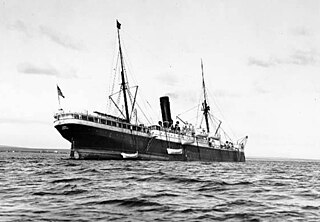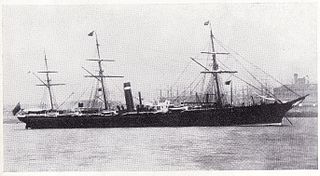Related Research Articles

The Pacific Mail Steamship Company was founded April 18, 1848, as a joint stock company under the laws of the State of New York by a group of New York City merchants. Incorporators included William H. Aspinwall, Edwin Bartlett, Henry Chauncey, Mr. Alsop, G.G. Howland and S.S. Howland.

SS City of Glasgow of 1850 was a single-screw passenger steamship of the Inman Line, which disappeared en route from Liverpool to Philadelphia in March 1854 with 480 passengers and crew. Based on ideas pioneered by Isambard Kingdom Brunel's SS Great Britain of 1845, City of Glasgow established that Atlantic steamships could be operated profitably without government subsidy. After a refit in 1852, she was also the first Atlantic steamship to carry steerage passengers, representing a significant improvement in the conditions experienced by immigrants. In March 1854 City of Glasgow vanished at sea with no known survivors.

SS Saale was an ocean liner for North German Lloyd in the late 19th century, which was severely damaged in the 1900 Hoboken Docks Fire. On 30 June 1900, Saale was moored at the North German Lloyd piers in Hoboken, New Jersey, preparing to depart on a transatlantic crossing when some cotton on a nearby pier caught on fire and spread to the ship. Saale and several other ships were soon engulfed in flames; 99 passengers and crew on Saale were killed in the fire and subsequent sinking.

SS Abyssinia was a British mail liner built in 1870, and originally operated by the Cunard Line on the Liverpool–New York route. She later served the Guion Line on the same route and the Canadian Pacific Line in the Pacific. In December 1891, Abyssinia was destroyed mid-Atlantic without loss of life by a fire that started in her cargo of cotton, highlighting the danger in carrying both cotton and passengers on the same ship.

Arizona was a record breaking British passenger liner that was the first of the Guion Line's Atlantic Greyhounds on the Liverpool-Queenstown-New York route. One nautical historian called Arizona "a souped up transatlantic hot rod." Entering service in 1879, she was the prototype for Atlantic express liners until the Inman Line introduced its twin screw City of New York in 1889. The Arizona type liner is generally considered as unsuccessful because too much was sacrificed for speed. Laid up in 1894 when Guion stopped sailings, Arizona was sold four years later and briefly employed in the Pacific until she was acquired by the US Government for service in the Spanish–American War. As the US Navy's Hancock she continued trooping through World War I, and was scrapped in 1926.

SS El Sol was a cargo ship built in 1910 for the Morgan Line, a subsidiary of the Southern Pacific Company. During World War I, she was known as USAT El Sol in service with the United States Army and as USS El Sol (ID-4505) in service with the United States Navy. At the war's end, she reverted to her original name of SS El Sol.

SS Ohio was an iron passenger-cargo steamship built by William Cramp & Sons in 1872. The second of a series of four Pennsylvania-class vessels, Ohio and her three sister ships—Pennsylvania, Indiana and Illinois—were the largest iron ships ever built in the United States at the time of their construction, and amongst the first to be fitted with compound steam engines. They were also the first ships to challenge British dominance of the transatlantic trade since the American Civil War.

City of Paris was a British passenger liner operated by the Inman Line that established that a ship driven by a screw could match the speed of the paddlers on the Atlantic crossing. Built by Tod and Macgregor, she served the Inman Line until 1884 when she was converted to a cargo ship.

City of Brussels was a British passenger liner that set the record for the fastest Atlantic eastbound voyage in 1869, becoming the first record breaker driven by a screw. Built by Tod and Macgregor, she served the Inman Line until 1883 when she sank with the loss of ten people after a collision while entering the Mersey.

SS De Grasse was a transatlantic liner built in 1921 by Cammell Laird, Birkenhead, United Kingdom for Compagnie Générale Transatlantique, and launched in February 1924. In August 1924 De Grasse set sail on her maiden voyage from Le Havre to New York. After the fall of France to Nazi Germany, the ship was used as a barracks ship. Sunk at Bordeaux, France, during the German retreat, she was refloated, repaired, and put back into service. Over the years, she became Empress of Australia and then Venezuela. She ran aground off Cannes, France, in 1962 and was scrapped at La Spezia, Italy.
SS Comet may also refer to one of several commercial passenger steamships:

Scotia was a British passenger liner operated by the Cunard Line that won the Blue Riband in 1863 for the fastest westbound transatlantic voyage. She was the last oceangoing paddle steamer, and as late as 1874 she made Cunard's second fastest voyage. Laid up in 1876, Scotia was converted to a twin-screw cable layer in 1879. She served in her new role for twenty-five years until she was wrecked off of Guam in March 1904.

Lavia was a cruise ship that caught fire and sank in Hong Kong Harbour in 1989. She was built for Cunard White Star Line in 1947 as the cargo liner Media. In 1961 she was sold to Italy, rebuilt as an ocean liner and renamed Flavia. In 1969, she was refitted as a cruise ship and renamed Flavian. In 1982 she was sold to Panama and renamed Lavia. She was undergoing a refit when the fire occurred. The damage to her was so great that she was scrapped.

This is a timeline of the world's largest passenger ships based upon internal volume, initially measured by gross register tonnage and later by gross tonnage. This timeline reflects the largest extant passenger ship in the world at any given time. If a given ship was superseded by another, scrapped, or lost at sea, it is then succeeded. Some records for tonnage outlived the ships that set them - notably the SS Great Eastern, and RMS Queen Elizabeth. The term "largest passenger ship" has evolved over time to also include ships by length as supertankers built by the 1970s were over 400 metres (1,300 ft) long. In the modern era the term has gradually fallen out of use in favor of "largest cruise ship" as the industry has shifted to cruising rather than transatlantic ocean travel. While some of these modern cruise ships were later expanded, they did not regain their "largest" titles.
Several steamships have borne the name Stella:

The Oceanic class were a group of six ocean liners built by Harland and Wolff at Belfast, for the White Star Line, for the transatlantic service. They were the company's first generation of steamships to serve the North Atlantic passenger trade, entering service between 1871 and 1872.
Helsingfors was a Finnish freight and passenger steamship built in Belgium in 1903 for Helsingfors Ångfartygs Aktiebolaget. She ran aground and sank near Bengtskär on 1 January 1905. The accident resulted in the construction of the Bengtskär Lighthouse.
References
- ↑ https://web.lib.unc.edu/civilwar/index.php/2012/01/13/13-january-1862-wreck-of-the-city-of-new-york/
- ↑ https://www.newspapers.com/image/167447357/
- ↑ "The City of New York steam-ship on Daunt's Rock, at the entrance of Queenstown Harbour". The Illustrated London News. 9 April 1864. Retrieved 11 February 2021.
- 1 2 3 "Inman Line". TheShipsList. TheShipsList. 2005. Archived from the original on 17 January 2020. Retrieved 28 July 2020.
- ↑ "Duck Islands Claim Three More Lives". Syracuse Herald . Kingston, Ontario. 1931-01-18. Retrieved 2024-06-01.
- ↑ "CITY OF NEW YORK (1863, Propeller)". greatlakeships.org. Alpena County George N. Fletcher Public Library, Thunder Bay Research Collection. Retrieved June 1, 2024.
- ↑ Haworth, Rodger. "Single Ship Report for "2125460"". Miramar Ship Index (subscription). Retrieved 28 July 2020.
- ↑ Hocking, Charles (1969). Dictionary of Disasters at Sea during the Age of Steam 1824-1962. London: Lloyd's Register of Shipping. p. 146.
- ↑ Haworth, Rodger. "Single Ship Report for "5073923"". Miramar Ship Index (subscription). Retrieved 28 July 2020.